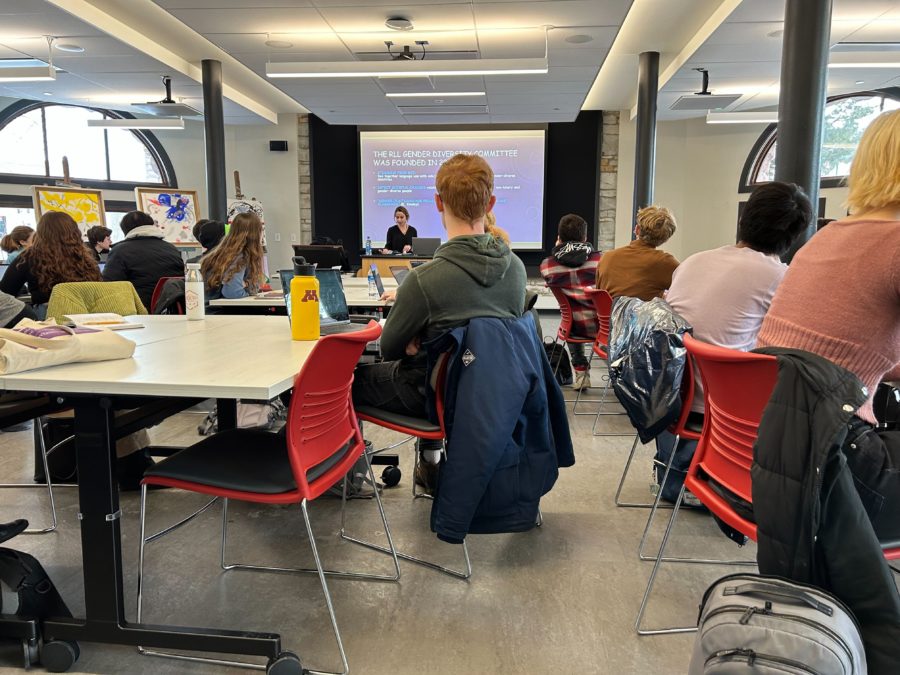The University of Minnesota Department of French and Italian hosted a seminar Feb. 28 on Romance languages evolving to include nonbinary and gender-diverse people and how second-language classrooms are approaching these changes.
The Romance languages are often referred to as Latin languages and include Spanish, Italian, French and Portuguese.
Romance languages have many words, including adjectives, nouns and pronouns, that are categorized as either feminine or masculine, potentially causing nonbinary and gender-diverse people to feel unrepresented by the language.
“The debate of gender-inclusive language [in Romance languages] is still very much going on, and there are a lot of options being proposed for gender-neutral pronouns,” said Michela Russo, a Spanish professor at the University of Michigan who co-founded the Gender Diversity Committee (GDC), at the seminar. “There is nothing static as of today.”
The GDC focused on researching what conversations were happening around gender and gender-neutral language in countries where most people speak Romance languages, according to Russo.
The GDC found languages are adapting to create non-gendered ways of referring to people who identify as nonbinary or gender-expansive.
“Language is very much alive and really depends on the practice of people,” Russo said.
However, gender-neutral language is not universally accepted or recognized. The Royal Spanish Academy and the French Academy, organizations responsible for preserving and maintaining their respective languages, do not currently recognize gender-neutral language.
Gender traditionally strict in Romance languages
Romance languages often have two gendered ways of assigning pronouns or adjectives to people and objects: masculine and feminine. This structure does not account for people who are nonbinary, or identify as neither strictly male nor female.
“Languages are not fixed entities,” Lorenzo Fabbri, the director of Italian Studies at the University, said in an email to the Minnesota Daily. “Nonbinary communities in Italy, France, Spain and Portugal are taking it upon themselves to innovate their native tongues to make them more inclusive.”
LangIn is a group of University graduate students researching the use of gender-neutral language in native speakers and its application in second-language classrooms, with their current focus primarily on Spanish.
Pronouns in Romance languages match the gender identity of the person they refer to, which is why speakers are developing gender-neutral pronouns to talk about nonbinary people, according to Fernando Gonzalez Lesniak, a member of LangIn.
The same can be said with adjectives in Romance languages. Adjectives must match the grammatical gender or gender identity of the subject, Gonzalez Lesniak said.
Some Spanish speakers have started using “e” or “x” as gender-neutral endings to adjectives, Gonzalez Lesniak said. Feminine words typically end in “a,” while masculine words end in “o” in Spanish.
Instructors implement gender-inclusive language in UMN classrooms
Foreign language instructors at the University are not currently required to teach how languages are adapting to become more gender-inclusive, according to William Viestenz, the chair of the University’s Department of Spanish and Portuguese Studies.
However, some instructors choose to work gender-neutral language into their curriculum. French instructor Lauren Goodspeed said she makes a conscious effort to introduce students to gender-neutral language options.
“Even beyond pronouns, there are so many aspects of the French language that are gendered, and so there are a lot of new forms and neologisms that are being used and proposed by trans and nonbinary communities in the French-speaking world,” Goodspeed said.
Viestenz and Goodspeed noted that one obstacle to incorporating gender-inclusive language is that many textbooks do not include gender-neutral pronouns or adjectives.
Viestenz said the Department of Spanish and Portuguese is currently working on creating and publishing its own textbooks, which would include discussions of gender-neutral options. A textbook will be developed in the 2023-24 school year for Spanish Composition and Communication (SPAN 3015W), a class with a typically high enrollment rate.
“We are making an effort to incorporate [gender-neutral language] even if our textbook doesn’t,” Goodspeed said. “When I’m teaching new grammatical concepts, I’m always going to provide additional nonbinary forms that aren’t necessarily introduced in the textbook.”














Mary P
Mar 16, 2023 at 10:58 am
Europeans in 2023 who genuinely want to be more inclusive should be supported but let’s not pretend the effort as described in this article is not deeply, shamefully and painfully ironic given that the many, many indigenous languages spoken in what we now call the americas reflect a profound respect for all 2 spirit / non binary relatives. It would be really refreshing if that reality were acknowledged among the proponents of inclusivity in romance languages.